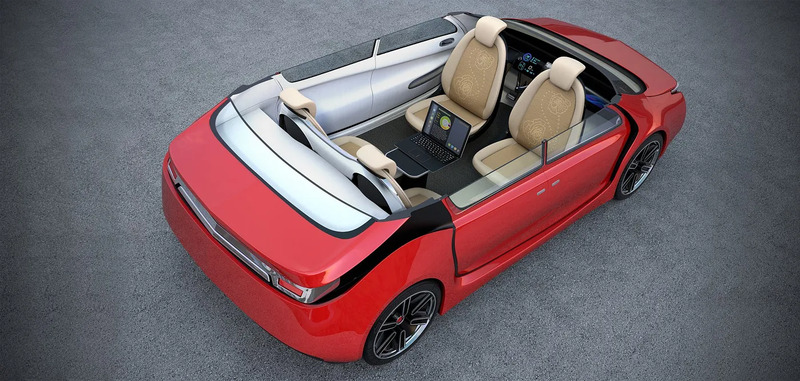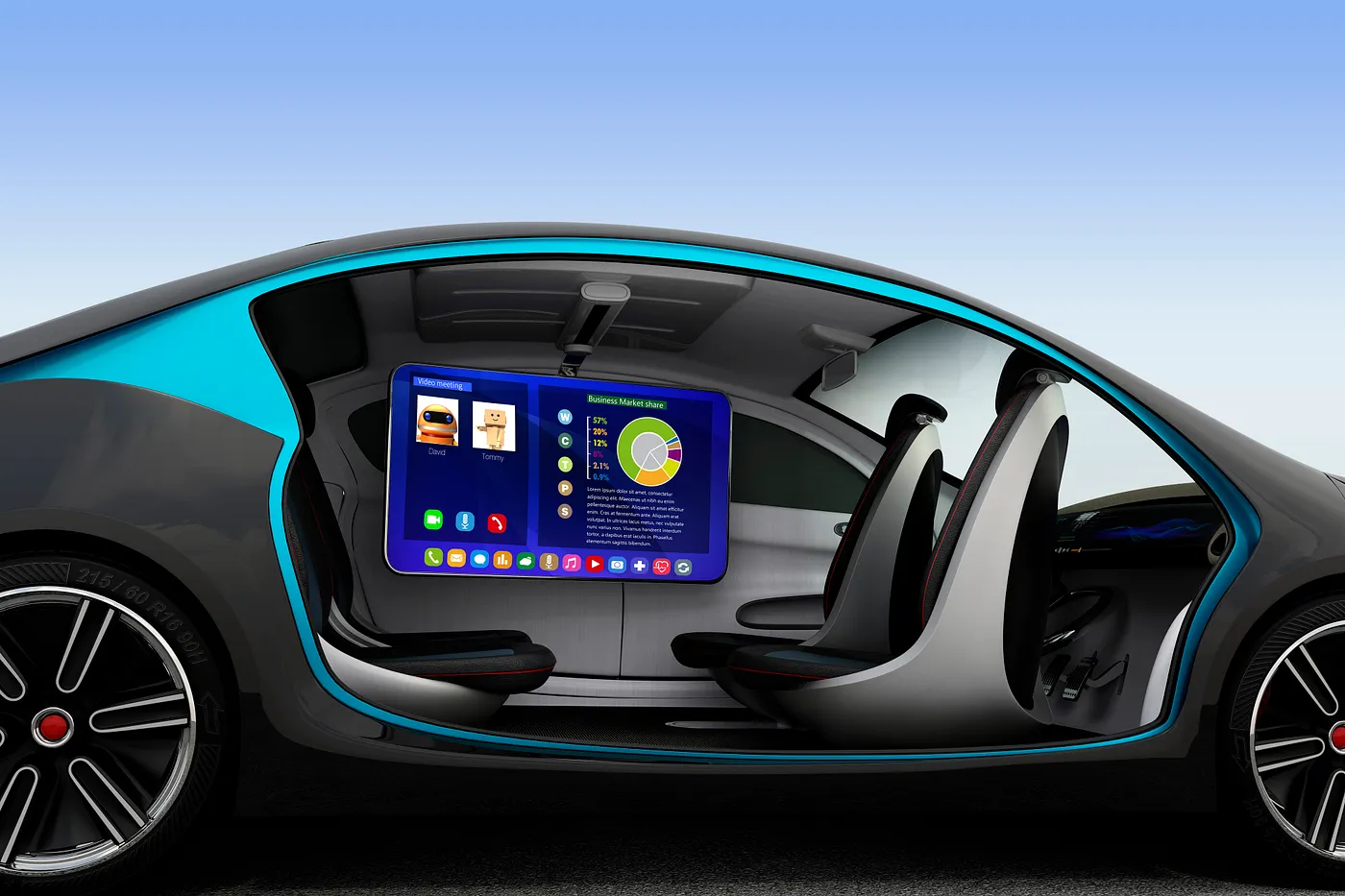
Autonomous car concept
One of the hallmarks of mankind’s technological progress is creating things that, while serving humanity one way or another, do not need any of its members to operate.
It was probably the factories with the increasingly unmanned production lines that started the snowball. What followed was, well, everything. Photobooths, war machines, customer service, warehouses, carwashes, spacecrafts, shops, vacuum cleaners even. And, as of late, cars.
TODAY: FASCINATION AND DOUBT
So, you have heard about autonomous cars. Of course you have. Most probably courtesy of Tesla, Google or Uber. You must have also heard about all the wonderful benefits such mode of transportation will bring compared to the current solution. First of all — computers are safer, more careful drivers than humans. I haven’t seen one drunk yet either. That means less crashes. A lot less, if we switch to AVs completely. Imagine a world where you are more likely to be struck by lightning, than be in a car crash. That much less. And considering car-related accidents are a top non-medical cause of death worldwide, this means countless saved lives. Add in all the resources that go into car and property repairs. Then add in the average of 50 minutes extra free time per person daily (in developed countries), and what you get is a lot of human and financial resources that can go into solving the remaining world problems.
While those are very real and potentially world-changing benefits, many talk about the challenges facing the self-driving car. Possibly the most crucial — and definitely the most interesting — is the ethical one. Let’s say your autonomous car faces an emergency situation on the road and two possible choices — one leading to your (driver’s) death, and the other one, to the car driving at high speed into a bus stop full of school children. The car must be programmed to make a decision. It could do everything to protect the driver and its passengers. But is society going to be fine with the cars doing this regardless of the damage they do in the process? Of course car’s algorithm could also make the rational decision to limit the human injuries and / or loss of life. But would you really be willing to buy a car that, in particular circumstances, is literally programmed to kill you? I didn’t think so.
This is definitely a problem the industry will have to solve in order to move on. Make no mistake however — move on it will. The only question is: how quickly.
TOMORROW ALWAYS COMES UNEXPECTED
In 1943 Thomas Watson, the chairman of IBM at that time, said “I think there is a world market for maybe five computers”. In 1977, with tens of thousands of computers already in use (mostly by government and corporations) Ken Olsen, founder of Digital Equipment Corp. declared that “there is no reason for any individual to have a computer in his home”. Just 4 years later Bill Gates himself is quoted saying that noone will ever need more than 640KB of memory in a personal computer. Right now the device each of us has in their pocket is equipped with as much as 10 000 times more RAM.
Let’s just say that we have a solid track record of underestimating the adoption rate and popularisation of new technologies. That’s why I hesitate to take current driverless car estimates with a customary grain of salt. I much prefer to add it by the pound. Current bold predictions include one made by Robert Hartwig, President of the Insurance Information Institute, saying that autonomous cars will really start populating US roads in the years 2028–2032, as well as a determination by IEEE (Institute of Electrical and Electronics Engineers) experts, that “up to 75% of all vehicles will be autonomous by 2040”.
75% by 2040? Seriously? Let me go on record with a prediction about year 2040 here. And it’s not even about autonomous cars, that would be too easy. It’s about the entirety of cars allowing human drivers. 100% of those will be owned by hobbyists, collectors and sports racing teams, since none of them will be allowed on any public road or street. And, by 2040, any other alternative will be quite unthinkable, the recklessness of allowing human-driven cars in public already a rather distant past.

AUTONOMOUS CARS: THE MARKETING FALLOUT
All this is good and interesting, but what does that have to do with marketing, you might ask. Well, if you think about it for a while, it turns out quite a lot. Much like most big technology-driven changes it will have severe ripple effect, and the advertising industry will not remain unaffected. And, much like all the bigger (the Internet) and smaller (VR) revolutions, those who see them coming earlier and better prepare for their arrival stand to gain the most — at the expense of those trying to hold on to the comfortable old ways of doing things. With this in mind, let’s see how much is really going to change.
I’ll start with the obvious and the biggest: the media. With drivers (or shall we rather say passengers) now free to focus full attention on things other than driving, their choice will most likely be visual, or even interactive, media. This should lead to even more consumption of video, social media (largely video) and online news (yes, still video). Once the line between video and computer games begins to blur (quite inevitable), cars will become be the perfect environment to submerge in such interactive entertainment, with little else to do with the time and virtually no interruptions. This will happen at the expense of other, albeit already dying medium, which will definitely not survive this blow and vanish once and for all. Do you know anyone who actually listens to the radio outside their car? Yeah, me neither. For the same reason music industry as a whole will take a hit. Not lethal though, it’s death to be delayed until all mundane jobs are outsourced to robots and people have no reason to run anymore, thus eliminating music’s most remaining applications pretty much limiting it to parties.
There will also be more direct and instant consequences. Digital and video advertising will gain a whole new group of recipients and a host of new possibilities. Targeting passengers with geolocalised communication will quickly become a hit. Think about interactive ads served via a computer system integrated with the car controls. The best ever McDonald’s ad? One in which clicking the CTA button makes the user’s car automatically pull into the upcoming Drive Thru, with his favourite meal already being prepared.
While digital advertising will be in the center of the changes, there will be offline consequences as well. The roadside billboards are currently designed to convey their message literally at a single glance. Driverless cars should open the road (oh, the pun…) to billboards as means of more complex communication. Interactive and customised as well, if they are allowed to wirelessly link with your onboard computer (next generation iBeacons) and pull your browsing history and Facebook likes. Retargeting on freeway billboards? Sooner than we think. Another interesting area is alcohol advertising. With drunk driving as the main reason for its limiting, will some of the restrictions be relaxed or even lifted?
THE BIG PICTURE
Autonomous cars will undoubtedly be a revolution with impact across many aspects of economy and human life. The thing to consider about any foreseeable trend however is whether there are others, possibly of a much greater magnitude, that could completely derail everything we expect to happen. And there might just be.
We keep hearing how autonomous cars will give us so more time at our disposal when going to and back from work. But will they really? We can assume that much like the role of the driver, robots and computers will soon take over most of other human roles and tasks that we today call jobs. They are already better than humans not just as construction workers, but also as engineers and architects. Not just as nurses, but also as surgeons and diagnosticians. Not just as client service, but also as accountants and investment fund managers. Of course, some work must still remain in human hands for quite a while, but even these jobs will increasingly be done from home, or anywhere else, really. So it’s fair to ask: will there even be any work-related commute at that point?
It won’t just be the work though. Physical location is going to quickly become meaningless in most other spheres of our life. Entertainment is already quite far along the way, with most free time spent at home using various electronic entertainment systems. Social life is also increasingly independent from actually meeting people. Just 20 years ago meeting someone was really the only way of meaningful contact (save for calling a landline or sending an actual letter), now we do the majority of our socialising without the other person in the room (and, often, the same continent). Even the last bastion of travelling — tourism — is not safe. VR is quickly progressing towards the point when the virtual experience of visiting any place in the world is just as real, while being faster, cheaper and offering fuller and more exhilarating experience. Once that happens, there will be little point in actual travelling.
Therefore it is a probable — even if quite ironic — scenario, that the time when mankind perfects it’s most advanced and reliable method of transportation to date, is also the time, when transportation as we know it becomes obsolete.





